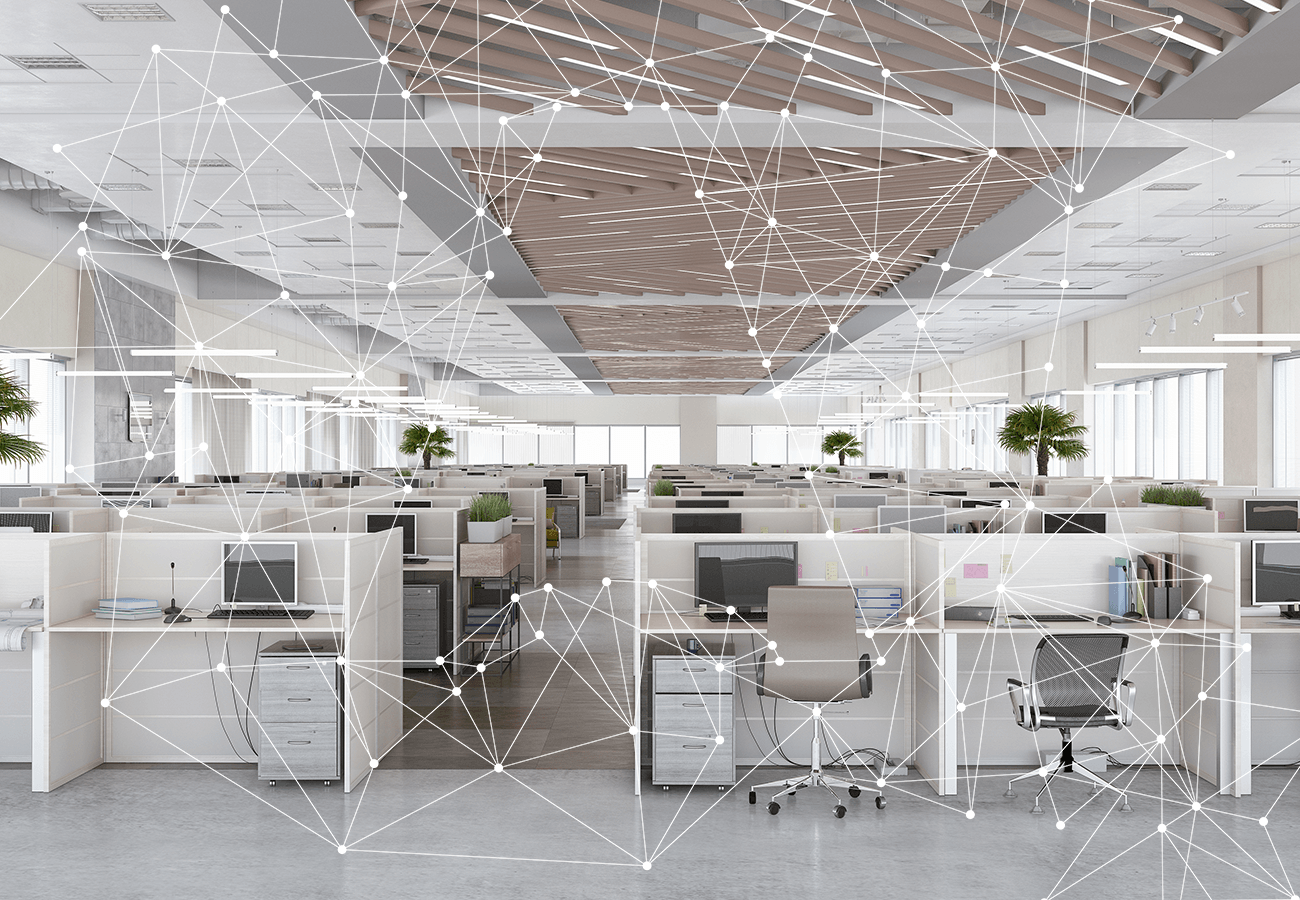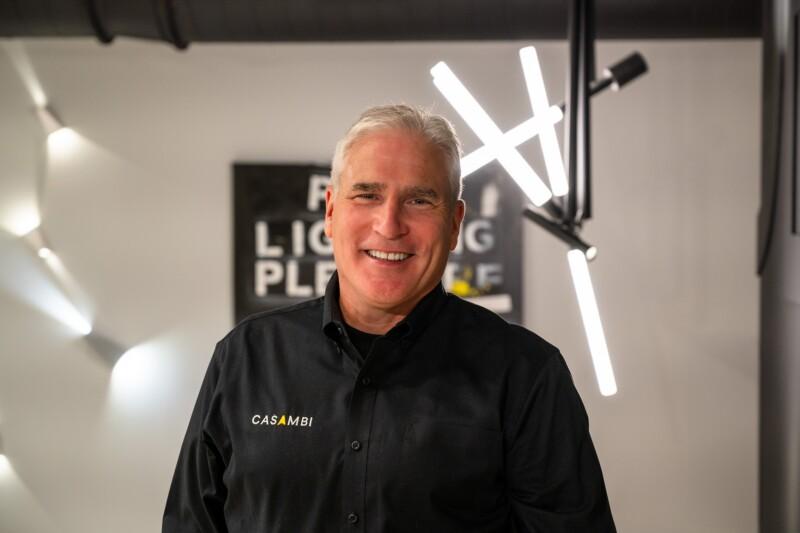Office lighting trends 2020

The modern office is not just a workplace where we sit at our desks. We jump between meetings, workshops, creative sessions and relax area for coffee breaks and networking. The flexible way of working has new requirements for the modern office and the lighting required within.
The most appropriate lighting is an indispensable element of creating a welcoming and productive office environment for employees. Considering that lighting as a basic necessity is an outdated concept, human-centric lighting, with appropriate hues and reaction to natural and ambient light, has been shown to boost productivity by 12%.
This is critical, given that the average office employee spends approximately 90% of their day indoors. The human body relies upon the circadian rhythm; an instinct based on the natural light that tells us when to sleep and when to be awake, and constant exposure to artificial illumination has a counteractive effect.
For that reason, more and more workplaces have embraced smart lighting, and in doing so, enabled a more comfortable environment for employees. Smart lighting boosts productivity, creates a functional and welcoming atmosphere, and enhances comfort and mental health.
It also offers many possibilities to give a beautiful aesthetic to any workspace with a vast range of design features that can be programmed to perform any number of tasks and scenarios as needed.
Flexibility
Whether moving into new business premises or overhauling an existing site, one of the most significant advantages of smart lighting is flexibility. This adjustability is vital in the modern business landscape, where the concept of the traditional nine-to-five working pattern grows increasingly outdated. Just as working patterns vary, lighting needs must be amended.
Workplace lighting should work in conjunction with natural, ambient lighting or lack thereof. There is no “one size fits all” approach to appropriate lighting; on a bright summer’s day, excessive light will create such things as screen glare, which can lead to eye strain, as opposed to the evening (or in winter for that matter) where artificial light bears the brunt of the work.
Smart lighting offers a flexible solution as it does not suffer from technical limitations and can be set to adapt to the unique circumstances surrounding illumination needs. This could be based around the individual, the group or even on a particular task.
The flexibility of smart lighting also extends to structure. Workplaces change and evolve constantly: desks might need to be repositioned and staff size may increase or decrease based upon business needs. Smart lighting does not require consideration of wall-mounted light switches when these decisions are made, which affords greater freedom when selecting a new layout for the workplace. Additionally, wireless sensors give even more flexibility with their ability to illuminate based on presence in a workspace and the amount of natural light.
Energy-efficiency and sustainability
LED lighting is already a big business and still growing, mainly due to its eco-friendly traits, and by 2024, the LED lighting market is expected to be valued at an impressive $US127.97 billion. Thankfully, the sustainability of LED lighting ensures that this value is shared – businesses can enjoy cost savings of up to US$18 billion thanks to the efficiency of this lighting.
If that is not motivation enough to make the change, consider the environmental impact. LED smart lighting can help reduce up to 160 million metric tons of carbon dioxide emissions, falling well below sustainable energy regulations in professional settings.
The flexibility of control over smart lighting also adds other eco-friendly credentials. Such functions as occupancy sensors and human-centric task lighting will reduce unnecessary energy consumption, with patterns programmed and memorized to ensure maximum efficiency.
Smart lighting can also work in conjunction with natural daylight, ensuring that unnecessary energy consumption is avoided, which will be less of a load put on the electric grid. With smart lighting, this is achievable without sacrificing the comfort of employees and other building users.
Wireless lighting control
While LED smart lighting is becoming increasingly sophisticated, wireless lighting control is getting more accessible and user-friendly as time goes on. The core idea behind wireless smart lighting is to put the power in users’ hands – first and foremost, by tailoring a workplace environment to the needs of those who work there.
Wireless lighting control is usually controlled by one staff member who can use either an app (e.g. the Casambi iOS or Android app) or an external handheld remote. As a typical office example, a meeting may occur in the boardroom that needs all eyes upon a large screen. Lights can be dimmed to ensure that glare against this screen is minimized, retaining all attendees’ comfort. Equally, lighting can be focused upon a particular individual with smart lighting creating a spotlight of sorts, providing the appropriate attention levels with just a touch of a button.
It should be noted that wireless lighting control is simple to install, as it makes use of existing wires and feeds. There is no need for a professional tradesperson to rewire an entire premise, charging for their time all the while and turning a workplace into a building site.
Individual control
Smart lighting enables different lighting levels that can be allocated for various tasks. This can be for varied scenarios such as bright, vibrant light if good visibility is needed. Still, if workshopping occurs, maybe less light and relaxed or energizing color temperatures are desired.
Lighting schemes can even consider individuals’ needs, such as differences in age and if more visibility is needed for the older demographic.
Human-Centric Lighting
Perhaps the most critical element of smart lighting is its human-centric approach. In the workplace, it ensures that employees remain alert, mentally sharp, and efficient. This does not just improve a business’s fortunes – it also means that employee churn will be reduced, as all staff is comfortable and content within the workplace environment.
Smart lighting is referred to as human-centric, due to the control over color temperature. By steadily adjusting the hues and intensity of light, the human body can replicate the experience of being outside. This is our natural state of being, as the sun’s rays govern the human body.
This approach can also be used to complement natural light that may pour in through an office window. If this is not an option, smart lighting can ‘replace’ natural sunlight. If an employee is fortunate enough to work in a light environment, smart lighting will not create conflict with the sun.
Over time, LED lighting has adapted to appear considerably more natural. For too long, artificial lighting – especially overhead strip lights in the workplace – were a harsh, unnatural bright white. Perhaps even worse was the dull, murky yellow of an outdated incandescent bulb. Smart lighting eradicates these concerns.
Use smart lighting to create an imitation of natural light so convincing that the human body is simply incapable of telling the difference. In essence, smart lighting brings the natural world inside the workplace.
Data and connectivity
Data has a more significant role in every business – also in lighting. In offices lighting sensor data can be used, for example, to identify available meeting rooms or in the long run for optimizing and developing space layouts by analyzing space utilization with heatmaps.
Data can be utilized as well for calibration of automated processes, such as ventilation or automatic UV-disinfectant. In a post COVID world with the data from occupancy sensors, one could see parts of the office have been used, and when there is no one in, lock the door and use UV light to clean the surfaces.
If you have any further queries about how smart lighting could benefit your office, do not hesitate to get in touch.


